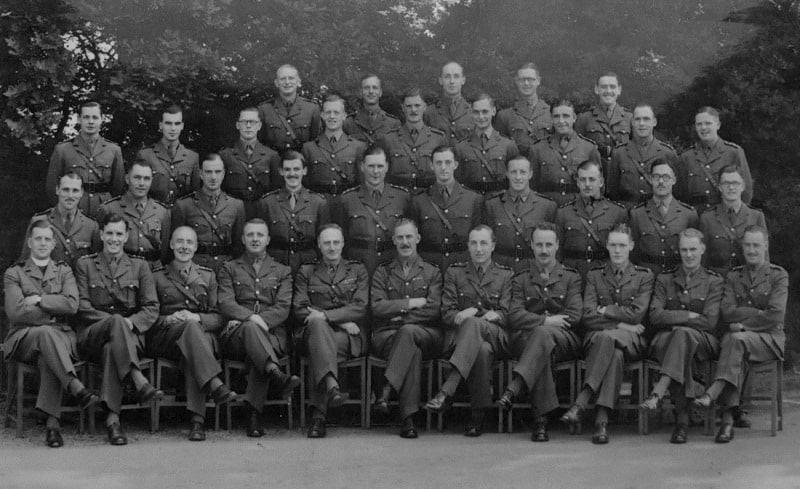March 1944; I joined the Essex Yeomanry as a newly commissioned nineteen year old. The Regiment was in Suffolk, in transit from Scotland where it had been training. Soon we moved to Bournemouth, to a requisitioned splendid hotel. There I did my first duty as Orderly Officer; I still remember RSM Mr Bennett’s kindness: “You did well” he said – but gave me the odd hint for next time! Then, transit again, the Bournemouth comfort was replaced by more modest canvas arrangements in a move to the New Forest, near Lymington. We prepared for D Day.
In the New Forest we worked hard waterproofing our newly acquired self-propelled guns and Sherman tanks. Waterproofing tests were done at Bucklers’ Hard. Many years later I had a mooring for my boat there; life moves on! I remember lots of welding being done on the chasses of the self-propelled guns – racks for gear; after all, gun crews need somewhere to stow their personal stuff.
My own transport for D Day, 6th June 1944, was a Bren carrier (a tracked vehicle) and we, a mixed bag of a few fellow passengers, including some Marine Commandos, embarked on a small landing craft. My impressive title was FOB (Fire Officer Bombardment) but, though I did have some training, I think I was about fourth reserve to replace those really doing the job who might become unavailable because of storm, shipwreck or enemy action! Anyway, this FOB failed to appear on duty off the Normandy Coast at 0700 hours as planned because his landing craft broke down in mid-channel. He finally arrived about lunchtime: a very suitable time. Lunch, I suspect, was an important occasion for pre-war Essex Yeomanry officers.
The weather was bad/doubful. The decision to go on the 6th June was finally made by Eisenhower at 04.30 on 5th June. Not surprisingly, the run-in shoot – the self-propelled guns firing from the LCT’s (Landing Craft Tanks) – was on occasion, perhaps imprecise. Moreover, the amphibious DD tanks which were to spearhead the seaborne assault were, in most cases, left to come ashore in the normal way on their tracks; several DD tanks failed to behave properly as boats!
In any battle confusion has a role; battles never works out quite as planned. The planning of D Day, the massive concentration of material, of military, naval and air power (nearly 8,000 ships and crafts set out from the British coast) the foresight to consider all possibilities and requirements, including failure in one or more areas, must have a place in military history; a tribute to Winston Churchill’s determination and vision.
After the initial assault on Gold Beach, 50 Division and the Eight Armoured Brigade with its three Regiments, the Essex Yeomanry’s self-propelled guns in support, reassembled for the decisive battles in Normandy and beyond. Perhaps the real baptism of fire for the Brigade and the Essex Yeomanry was on Point 103 – between June 9th-11th. The Essex Yeomanry had its guns below the summit of the high ground north of St Pierre, overlooking Tilly sur Seulles to the south. The Sherman tanks of the 24th Lancers formed a protective shield for the gun position. However, the position and its shield were attacked by Panzer tanks coming up the hill, through the woods, from St. Pierre. The position was held but the 24h Lancers lost several tanks. It was during this confrontation that my own F Troop BSM Broom was killed and, at St Pierre, Lieutenant Sayer, acting as an FOO, was also killed. His body was found several months later. Major Cecil Gosling, who commanded my own 511 Battery, was also wounded; F Troop’s Commander, “Blue” Lyon, took over the double role of his own job with F Troop and command of 511 Battery. Inevitably these events led to an enhanced role for junior officers in the Battery. Another factor operated; Armoured Regiments, subdivided into Squadrons, do not always operate as a single unit. Individual Squadrons often work on their own. That meant that the Forward Observation Officer (FOO) attached to the Regiment does not, as might happen in support of Infantry Battalions, stay with the Commanding Officer of the Regiment supported. The FOO may well be in his tank with one of the Squadrons. This, inevitably, led to a demand for more than one FOO; in that role, I would find myself in a tank from Brigade, permanently attached to the Essex Yeomanry for the purpose. I became known as “Dutch Foo”.
The attempt to relieve the airborne forces at Arnhem is history often debated. After the liberation of Brussels and Nijmegen, the 8th Armoured Brigade took over the lead from the Guards Armoured division along the narrow dyke towards Arnhem. The whole Arnhem episode was a bold plan to end the war quickly, but I think history has confirmed it as a gallant failure which might have succeeded. I had a small, private, sub-plan. I hoped to be able to liberate my uncle and his family who lived on the other side of the Rhine at Deventer. That didn’t come off either! The war was to last a bit longer.
The arrangements of FOO support were given further variety; the Regiment was in support of the Staffordshire Yeomanry’s DD tanks for the crossing of the Rhine. After a brief instruction on DD tanks and indoctrination in their jargon e.g. “lower prop”, I find myself crossing the river. In 2010 driving through Wales to visit a son in Ireland, I called on Phil Berry, one of the crew members of that tank. He reminded me that 66 years ago, in the Netherlands, we got stuck in the mud on the far side of the Rhine! Such is the fellowship of water transport!
Despite its horrors and tensions, war is also a forcible schoolmaster. Fellowship emerges and it can create a wonderful sense of belonging to one’s regiment. During the Normandy campaign our Commanding Office, Colonel Arthur Phayre, was promoted to become CRA of 11th Armoured Division. At the end of the war and demobilisation, the army was reduced to peacetime size. Thus many officers dropped down from their wartime rank. Brigadier Phayre reverted to being in command of 5th RHA (Royal Horse Artillery). Loyal to his Essex Yeomanry days, he wrote to me asking if I would like to be adjutant of his new command. It would have been a great opportunity if I was to become a regular soldier; of course, I was tempted.
Deciding, instead, to try for Cambridge and get myself educated, I was accepted, not by virtue of academic merit or promise; I had been in the 1939-45 war, and the Admissions Tutor of my College had served in the 1914-18 war! Many years later, as Headmaster of an Independent School, I was able to invite Colonel Arthur Phayre to a Guest Night at the School. Perhaps a curious and delayed way for a young officer who was at the time, little more than a schoolboy, to express thanks for his good fortune in his formative and war-time years.
In that perceptive analysis of the world at war, 1939-45, ‘All Hell let Loose’ Max Hastings reflects on the casualty figures, the tragedy and misery for both civilians and soldiers on both sides of the conflict. The final paragraph of the book judges the 1939-45 war as “the greatest and most terrible event in human history. Within the vast compass of the struggle, some individuals scaled summits of courage and nobility while others plumbed depths of evil in a fashion that compels the awe of posterity.”
War is strange. Death, destruction, cruelty, confusion, loss of familiar signposts are all its elements. Yet, it does, too, conjure other things to be remembered – comradeship, the fellowship of a tank crew, loyalty, small incidents which renew ones faith in humanity. Those elements are collectively called peace.
After a victory parade in Hanover the Essex Yeomanry moved to Kiel where it guarded the naval barracks. It then gradually dispersed, its senior officers demobilised, its younger ones sent elsewhere with the invasion of Japan in mind. Fortunately, Japan surrendered first.
Marc van Hasselt (OC)
Ref: D-Day – Anthony Beevor,, All Hell Let Loose – Max Hastings D-Day to Berlin – Andrew Williams
Back to all news











